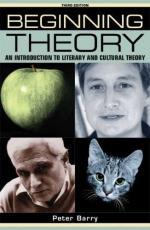
|
| Name: _________________________ | Period: ___________________ |
This test consists of 15 multiple choice questions and 5 short answer questions.
Multiple Choice Questions
1. W.B. Yeats was a member of the ________ ruling class in ________, according to the narrator in the chapter titled "Postcolonial Criticism."
(a) Aethist / America.
(b) Jewish / Poland.
(c) Protestant / Ireland.
(d) Amish / Sweden.
2. Karl Marx and Friedrich Engels were the join founders of the school of________ according to the Chapter titled "Marxist Criticism."
(a) Reason.
(b) Expectations.
(c) Englightenment.
(d) Thought.
3. Ecocriticism was a term that was applied to the work previously known as what form of writing?
(a) Scientific.
(b) Nurture.
(c) Biological.
(d) Nature.
4. ________ is a co-founder of ecocriticism with Harold Fromm that developed in the early-1990s in the USA.
(a) Cheryll Glotfelty.
(b) Robert Heinlein.
(c) Frank Herbert.
(d) George Orwell.
5. According to the chapter "Stylistics," in medieval times rhetoric played an important part in training people for the ________, the legal profession, and political or diplomatic life.
(a) Church.
(b) Library.
(c) Court.
(d) School.
6. What is thecritical approach which uses the methods and findings of the science of linguistics in the analysis of literary texts?
(a) Grammatology.
(b) Ambiguity.
(c) Intersubjectivity.
(d) Stylistics.
7. Which of the following realism terms best illustrates the straight realism which was imposed in the 1930s?
(a) Confederate Realism.
(b) Republican Realism.
(c) Socialist Realism.
(d) Democratic Realism.
8. According to Peter Barry, the term "new historicism" was coined by the ________ critic Stephen Greenblattt.
(a) Russian.
(b) American.
(c) German.
(d) Italian.
9. The narrator explains that conventional ________ is often seen by the stylistician as impressionistic, intuitive, and randomized.
(a) Emotive language.
(b) Close reading.
(c) Surface structure.
(d) Constative language.
10. What was the name of the Nigerian novelist who published his first novel, "Things Fall Apart," in 1958, and was criticized by an early reviewer for affecting identity with African villagers?
(a) William Faulkner.
(b) Kurt Vonnegut.
(c) Chinua Achebe.
(d) J.R.R. Tolkien.
11. The narrator explains that narratology studies how narratives, or stories, creates ________.
(a) Money.
(b) Meaning.
(c) History.
(d) Icons.
12. The narrator details that ________ believed that some speech was reported while other speech was mimetic, transposed, or narratized.
(a) Galileo Galilei.
(b) Aristotle.
(c) Plato.
(d) Genette.
13. The narrator believes that after the moment of theory there comes, inevitably, the ________ of theory, when it ceases to be the exclusive concern of a dedicated minority and enters the intellectual bloodstream.
(a) Year.
(b) Week.
(c) Hour.
(d) Month.
14. A poem of which author is provided by Peter Barry as an example of ecocriticism?
(a) Thomas Hardy.
(b) Geoffrey Chaucer.
(c) D.H. Lawrence.
(d) Vladimir Nabokov.
15. Who does Peter Barry credit with partially defusing the conflict between heterosexual feminists and lesbians in an important essay which introduced the notion of the "lesbian continuum"?
(a) Adrienne Rich.
(b) Bonnie Zimmerman.
(c) Anne Koedt.
(d) Muriel Spark.
Short Answer Questions
1. What was the name of the American journal that was considered the "house magazine" of the new historicism?
2. According to the narrator, post-colonial criticism gained currency through the influence of all the following books except for which one?
3. Who wrote the 1986 book "Linguistic Criticism," which characterized linguistic criticism as "objective description of texts"?
4. What is the term used to describe the study of narrative structures that combines characteristics and is derived from structuralism and linguistic theory?
5. During the 1980s, linguists consulted and incorporated non-linguistic material in which came to be called the ________, which had a limited degree of eclecticism and was less likely to claim that it alone studied literature in an objective way.
|
This section contains 541 words (approx. 2 pages at 300 words per page) |

|




